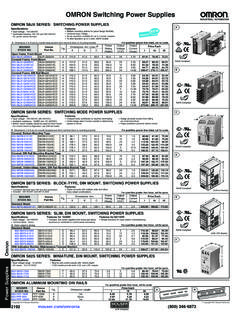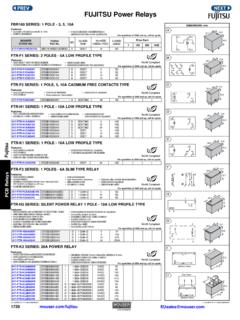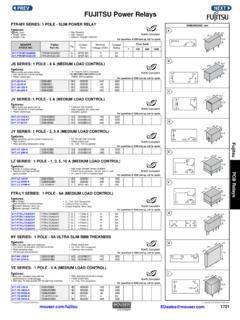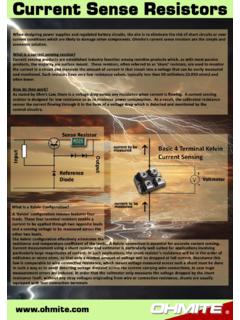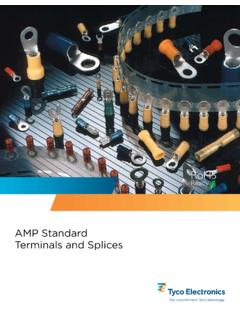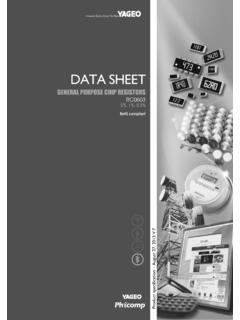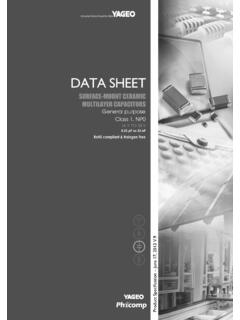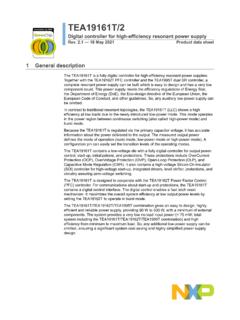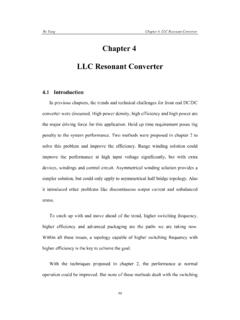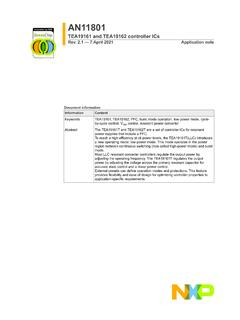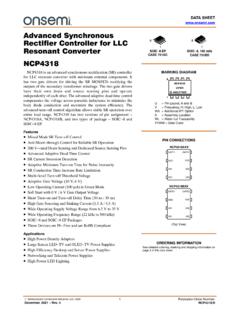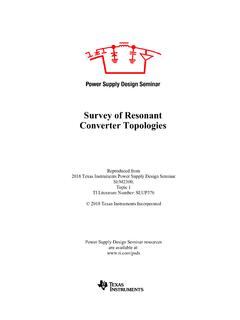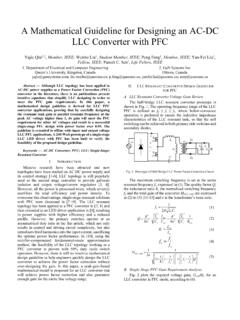Transcription of LLC Converter Design Note - Mouser Electronics
1 Design Note AN 2013-03 March. 2013 L L C C o n v e r t e r D e s i g n N o t e IFAT IMM PSD Anders Lind LLC Converter Design 2 Design Note AN 2013-03 March. 2013 Edition 2013-03 Published by Infineon Technologies Austria AG 9500 Villach, Austria Infineon Technologies Austria AG 2011. All Rights Reserved. Attention please! THE INFORMATION GIVEN IN THIS APPLICATION NOTE IS GIVEN AS A HINT FOR THE IMPLEMEN-TATION OF THE INFINEON TECHNOLOGIES COMPONENT ONLY AND SHALL NOT BE REGARDED AS ANY DESCRIPTION OR WARRANTY OF A CERTAIN FUNCTIONALITY, CONDITION OR QUALITY OF THE INFINEON TECHNOLOGIES COMPONENT. THE RECIPIENT OF THIS APPLICATION NOTE MUST VERIFY ANY FUNCTION DESCRIBED HEREIN IN THE REAL APPLICATION. INFINEON TECHNOLOGIES HEREBY DISCLAIMS ANY AND ALL WARRANTIES AND LIABILITIES OF ANY KIND (INCLUDING WITHOUT LIMITATION WARRANTIES OF NON-INFRINGEMENT OF INTELLECTUAL PROPERTY RIGHTS OF ANY THIRD PARTY) WITH RESPECT TO ANY AND ALL INFORMATION GIVEN IN THIS APPLICATION NOTE.
2 Information For further information on technology, delivery terms and conditions and prices please contact your nearest Infineon Technologies Office ( ). Warnings Due to technical requirements components may contain dangerous substances. For information on the types in question please contact your nearest Infineon Technologies Office. Infineon Technologies Components may only be used in life-support devices or systems with the express written approval of Infineon Technologies, if a failure of such components can reasonably be expected to cause the failure of that life-support device or system, or to affect the safety or effectiveness of that device or system. Life support devices or systems are intended to be implanted in the human body, or to support and/or maintain and sustain and/or protect human life. If they fail, it is reasonable to assume that the health of the user or other persons may be endangered.
3 AN 2013-03 Revision History: date (13-03-08) , Previous Version: none Subjects: [First rev] Authors: [Anders Lind, IFNA PMM] We Listen to Your Comments Any information within this document that you feel is wrong, unclear or missing at all? Your feedback will help us to continuously improve the quality of this document. Please send your proposal (including a reference to this document) to: LLC Converter Design 3 Design Note AN 2013-03 March. 2013 Table of contents 1 Introduction .. 4 2 LLC Converter Topoology .. 4 3 Design Equations .. 5 Converter gain .. 6 Determining resonant components .. 7 Rectifier diode considerations .. 10 MOSFET considerations .. 11 Output filter considerations .. 14 resonant reactive elements considerations .. 15 Controller/driver considerations .. 16 4 References .. 17 LLC Converter Design 4 Design Note AN 2013-03 March. 2013 1 Introduction LLC topology has been used sparingly in high-end applications that required the very highest efficiency possible.
4 However, with industry demanding increased efficiency in more mainstream products and organizations such as Energy Star and 80 Plus posting ever higher recommendations for efficiency at any load-level, LLC topology is proliferating throughout product categories and power levels. While this topology handles load variarations extremely well, it requires substantial upfront effort to configure a Design to handle line variations this must be fully considered in the resonant tank Design , and a wider input range Design will have some specific trade-offs. Use LLC in off-line SMPS with a pre-regulated bus (PFC) when efficiency and power density are high priorities. This Design note aims to detail the operation of the LLC Converter in its three different modes as well as provide guidance on how to properly Design an LLC stage. A detailed example is provided with component selection and worst-case loss calculations for all semiconductor components.
5 2 LLC Converter Topoology The LLC Converter is part of the resonant Converter family, which means regulation is not like conventional Pulse Width Modulation schemes. Running at 50% Duty cycle and fixed 180 degree phase shift, regulation is obtained through frequency modulation. All primary side MOSFETs turn on resonantly Zero Voltage Switching resulting in full recycling of the energy contained in the MOSFETs parasitic output capacitance. Furthermore, all secondary side switches turn off resonantly Zero Current Switching to minimize switching losses normally associated with hard switching. resonant operation of all switching devices in the LLC Converter results in minimized dynamic loss and thus increased overall efficiency; particularly at higher operating frequencies in the hundreds of kilo Hertz to Mega Hertz range. LLC Converter Design 5 Design Note AN 2013-03 March.
6 2013 Key waveforms Figure : Schematic and basic waveforms for HB LLC Converter operating at resonant frequency. 3 Design Equations The following are Design equations for the LLC Converter , including a Design example using Half Bridge front-end and two center-tapped, passively rectified outputs to clarify the use of the equations. The example uses a proposed Design process to establish resonant tank component values based on certain guidelines. Input voltage {Vi} 320 V-420 Vdc (PFC pre-regulated bus universal ac) Output voltage 1 {Vo1} 24 V Maximum output current 1 {Io1,max} 6 A Output voltage 2 {Vo2} 12 V Maximum output current 2 {Io2,max} 5 A Maximum power {Po,max} 204 W Switching frequency {fs} 100 kHz, nominal at full load, 380 Vdc Table : Specifications ACPFC ConverterDC/DC ConverterLoadDC BusVacViS1S2 LrCrLMW1 W2 W2 W3 W3D1D2D3D4Co1Co2Co3Co4Lo1Lo2Vo1Vo2VS2Ir (ILM)ViS1D1S2D2IS10n (Ir ILM)ID10VS1Vi0 VBrVi0IS200 IrIrVD12 Vo0n (Ir ILM)ID2VD22 Vo00 LLC Converter Design 6 Design Note AN 2013-03 March.
7 2013 Converter gain The winding ratio between the primary winding, npri, and the secondary winding, nsec, gives one gain-term as in other transformer isolated SMSP: priXFMRnnGsec (1) Since the resonant Converter gain is expressed with respect to sinusoidal in- and out-puts, both need conversion, which results in a total gain factor of 1,21 FBHBGG (2) For Half-bridge or fullbridge front-ends respectively. The last gain-term is the one for the resonant network: 222222221111),,(QmFxFxFxmmFxFxmQK (3) Where acrrRCLQ Quality factor (4) opriacRnnR 2sec228 Reflected load resistance (5) rsffFx Normalized switching frequency (6) rrrCLf 21 resonant frequency (7) rmrLLLm Ratio of total primary inductance to resonant inductance (8) The resonant gain will have a general shape as shown below in Figure : Figure : Shape of the resonant gain at different values of Q Gain is 1 at Fx=1 and lower for Fx>1.
8 Assuming Q<1, gain is higher for Fx<1. The minimum frequency of operation is limited to the frequency at which the gain peaks. The amplitude of the peak represents the maximum gain. Rac is a function of output voltage and output current, which are given at maximum output , Fx, () , Fx, () , Fx, () , Fx, ()K1m, Fx, ()K5m, Fx, ()FxCapacitive regionZCSI nductive region ZVSm=6 Light loadHeavy loadLLC Converter Design 7 Design Note AN 2013-03 March. 2013 power . The Lr * Cr product is given by (7) {fr is selected to equal the desired switching frequency at nominal operation to obtain best efficiency at that operating point}. A larger Lr (and smaller Cr) results in a lower maximum gain via Q. m is the only variable that contains Lm (the transformer magnetizing inductance). A larger value of Lm brings the transformer closer to ideal and improves efficiency, but makes it harder to achieve ZVS.
9 A larger value of Lm also reduces maximum possible gain: Q and m influence each other and determine maximum gain. The ratio of maximum gain to nominal gain (a gain of 1) must be high enough to accommodate for the ratio of nominal input voltage to minimum input voltage. This cannot be made up for by the other (non-frequency dependent) gains. Determining resonant components Given the specifications in Table , we can see that the minimum resonant gain required is ,,min, inomiViVVG (9) When adding 10% for head room. The resonant frequency, fr, is set equal to the desired switching frequency for best efficiency. Picking the right optimal maximum Q and m values is a very involved task that requires iterations, physical experiments and complex calculations, which is not the purpose of present Design Note. Instead some guidelines will be followed. Figure shows gain plots for several values of Q in the range from small ( ) to large (5) for some quasi-arbitrarily chosen value of m=6.
10 At the maximum Q (heaviest load), the minimum resonant gain (determined above in (9)) must be achievable. A value of QMAX higher than ~ will probably not satisfy the requirements. Q will have its minimum value at light loads, where the gain curve becomes very shallow at higher frequencies. The Converter must be able to buck the voltage enough when the input voltage is high. Subtracting 10% for tolerances, the bucking-gain is obtained: ,,max, inomiViVVG (10) We see from Figure that Qmax values less than ~ will result in high frequency at high input voltages which will decrease efficiency (added switching loss). A good choice of Qmax is somewhere in the middle: Q (11) LLC Converter Design 8 Design Note AN 2013-03 March. 2013 Since Qmax has been solidified, we must pick the highest m-value that satisfies the minimum gain requirement (remember that high m is desirable, since the transformer is more ideal).
